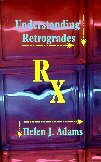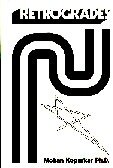
|
The Astrology Center of America, 207 Victory Lane, Bel Air, MD 21014 Tel: 410-638-7761; Toll-free (orders only): 800-475-2272 |
|||||||
|---|---|---|---|---|---|---|---|
| Home | Author Index | Title Index | Subject Index | Vedic Books | Tarot | E-Mail: | |
 |
Retrograde Planets |
Good writing about retrogrades can be scarce, so we'll give a short primer: Retrogrades have to do with the angular aspect between a planet and the sun, as viewed from the earth. When planets reach a precise number of degrees away from the sun (consult your ephemeris), they go retrograde. When they reach the same angle again, they go direct. So all sun - planet oppositions are retrograde. For that matter, all oppositions (except those of the moon) involve one planet retrograde, one direct. (Other aspects are just as interesting.) The further the distance in miles a planet is from the sun, the more its retrograde is a generational affair. How much of a generation are we talking about? Did you know that every Aquarian born between 1900 and 1985 had a retrograde Pluto and almost as many people born in April have a retrograde Neptune? So for an outer planet retrograde to be personal, it seems to us that it must be either in aspect to the sun, or angular in the chart. We could go on, have a look at the books while we think about it:
See books on Mercury retrograde on the Mercury page.
 |
||
 |
||

|
||
 |
||
 |
||

207 Victory Lane, Bel Air, MD 21014
Tel: 410-638-7761; Toll-free (orders only): 800-475-2272
| Home | Author Index | Title Index | Subject Index | Vedic Books | Tarot | E-Mail: |
Established 1993, The Astrology Center of America is owned & operated by David Roell.
This entire site (AstroAmerica.com) is copyright 1996, 1997, 1998, 1999, 2000 by William R. Roell.
All rights reserved.